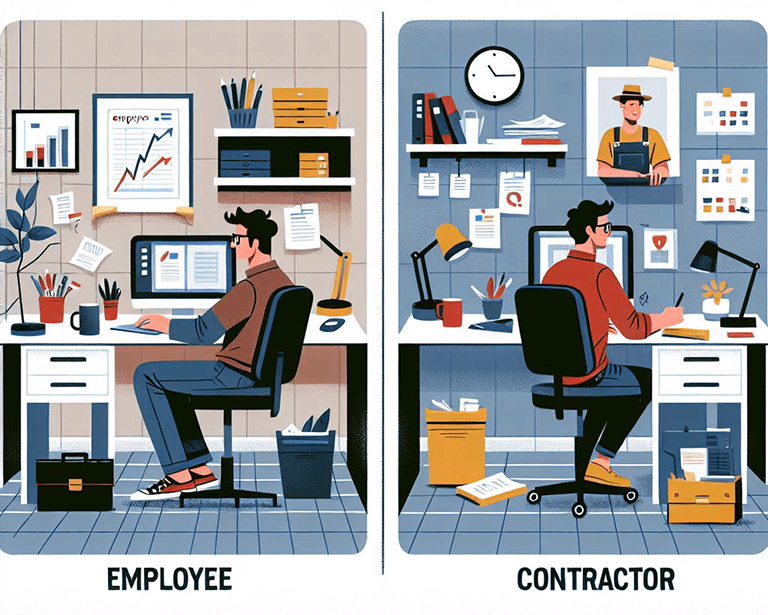A Detailed Exploration of Compliance regarding Contractor vs. Employee Classifications
When determining whether a worker should be classified as an independent contractor or an employee, it is vital to understand the implications and legal requirements of these classifications. Misclassifying workers can have profound and costly consequences for businesses. The growing scrutiny from agencies such as the Department of Labor (DOL), the California Employment Development Department (CA EDD), and the Internal Revenue Service (IRS) makes it critical for companies to correctly classify their workers. Doing so helps avoid legal penalties, back wages, tax liabilities, and other financial repercussions.
Worker classification is not just a matter of convenience or cost-saving. It’s a significant legal decision that must be based on the nature of the working relationship between the worker and the company. Misclassification may seem like a technical error, but the financial and reputational damage that can result from failing to comply with relevant laws can be severe. In this expanded discussion, we will dive deeper into the consequences of worker misclassification and the factors that should be considered to make an informed decision, as well as the legal frameworks that govern these classifications.
The Importance of Compliance

The most important reason for correctly classifying workers is to comply with federal and state labor laws. The IRS, DOL, and state agencies like CA EDD have specific guidelines and tests to help businesses determine the proper classification. Misclassifying a worker can trigger various legal issues, including:
- Back Wages: If a worker has been incorrectly classified as an independent contractor when they should have been classified as an employee, the company could be liable for unpaid overtime and minimum wage violations under the Fair Labor Standards Act (FLSA). Employees are entitled to wage protections that independent contractors are not. In cases of misclassification, the company may be required to pay back wages dating several years back.
- Tax Penalties: Misclassification can lead to substantial tax liabilities. Employers are required to withhold and pay income, Social Security, and Medicare taxes for employees. Independent contractors, on the other hand, are responsible for paying their own self-employment taxes. If the IRS determines that a worker was improperly classified, the employer could face back taxes along with interest and penalties.
- Benefit Liabilities: Employees are often entitled to various benefits, including health insurance, retirement plans, and paid time off, which are not extended to independent contractors. Misclassified workers may file lawsuits to claim these benefits retroactively, leading to costly legal battles and back payments. Businesses may also be required to enroll these workers in unemployment insurance and workers’ compensation programs.
- Unemployment Insurance: Employees, not independent contractors, are entitled to unemployment benefits if they are laid off or their working relationship is terminated. If a company is found to have misclassified workers, it may be required to retroactively pay unemployment taxes for these workers, along with penalties and interest.
- Workers’ Compensation: Employers are generally required to provide workers’ compensation insurance for their employees, but not for independent contractors. A misclassified worker could file a workers’ compensation claim for an on-the-job injury, and the company may find itself liable for the worker’s medical expenses and lost wages. Additionally, some states impose stiff penalties for failing to carry workers’ compensation insurance for employees.
Factors in Determining Worker Classification
While there is no single test that definitively determines whether a worker is an employee or an independent contractor, several key factors are commonly used by regulatory bodies like the IRS, DOL, and CA EDD to make this determination. These factors focus on the degree of control the company has over the worker and the independence of the worker in carrying out their tasks. The following are some of the most significant considerations:
1. Income Sources
One of the most distinguishing features of independent contractors is that they typically have multiple clients or sources of income. An independent contractor operates a business and is not economically dependent on one company for their livelihood. If a worker earns the majority of their income from a single company, that company may be their primary employer, and they should likely be classified as an employee. This economic dependence is a red flag for misclassification.
Conversely, employees typically rely on their employer as their main or sole source of income. They are often under contract to work a specified number of hours each week and are compensated based on time spent rather than the completion of a specific task or project.
2. Payment Structure
Another critical factor in classification is how the worker is compensated. Independent contractors are usually paid per project or for completing specific deliverables. Their payment is not tied to the number of hours they work but to the value of the services they provide. For example, a graphic designer might be paid a flat fee to design a website, regardless of how long it takes to complete the work.
On the other hand, employees are generally paid on an hourly, weekly, or monthly basis. Their compensation reflects the time they spend working rather than the completion of a particular project. If a worker is being paid regularly by the hour, week, or month, and their pay is not contingent on specific project deliverables, it may be an indication that they should be classified as an employee.
3. Company Involvement
The level of involvement the worker has in the company’s daily operations is another significant consideration. Independent contractors are typically hired for specific tasks or projects that require specialized skills. They are brought in to perform work that is not integral to the company’s core business functions and are generally not involved in the company’s management or decision-making processes.
If a worker is involved in managing employees, overseeing major projects, or engaging in the company’s strategic decisions, this could signal that they are functioning as an employee rather than an independent contractor. Employees often hold positions that are central to the company’s operations, such as managerial roles or long-term project leaders.
4. Control Over Work
The degree of control the company exerts over how the worker performs their job is one of the most critical factors in determining classification. Independent contractors have a significant amount of control over how they complete their work. They decide how, when, and where to perform their tasks, and they typically set their own schedules. They also provide their own tools and equipment, and they work independently of the company’s internal processes.
In contrast, employees are usually subject to the company’s control over how their work is performed. The company may dictate the hours they work, the tools they use, and the processes they follow. If a company is closely supervising a worker’s activities, it suggests an employer-employee relationship.
5. Provision of Benefits and Equipment
Independent contractors typically do not receive benefits such as health insurance, retirement contributions, or paid time off. They also provide their own tools and equipment necessary to complete their work. If a company is providing a worker with benefits or covering the costs of equipment, it may suggest that the worker is an employee rather than an independent contractor.
Employers who misclassify workers in this area could find themselves facing claims for benefits and may be required to provide retroactive compensation for benefits that should have been extended to employees.
Legal Guidance and Resources
To help companies avoid the costly consequences of misclassification, various resources are available. The IRS provides clear guidelines on the classification of independent contractors and employees. Their “Common Law Rules” focus on three key areas: behavioral control, financial control, and the nature of the relationship between the worker and the company. See: The IRS definition of an Independent Contractor
Additionally, the DOL offers guidance on determining whether a worker should be classified as an employee under the Fair Labor Standards Act. See: Department of Labor: Employee vs Contractor
Companies should also consult state-specific guidelines, such as those provided by CA EDD, which has its own set of criteria for worker classification, particularly relevant to businesses operating in California.

Conclusion
Accurately classifying workers as either employees or independent contractors is critical for businesses to avoid legal and financial risks. By understanding the factors that distinguish these two classifications and ensuring compliance with federal and state laws, companies can protect themselves from costly penalties and legal liabilities. Misclassification may seem like a minor administrative issue, but its impact can be severe, including back wages, tax penalties, benefit claims, and legal fees. Companies should carefully evaluate the nature of their working relationships with all workers and seek professional legal guidance if necessary to ensure compliance.
If you would like assistance with your employee classifications, FSMC Bookkeeping Services partners has a team of HR professionals ready to help. Contact Us Today.

